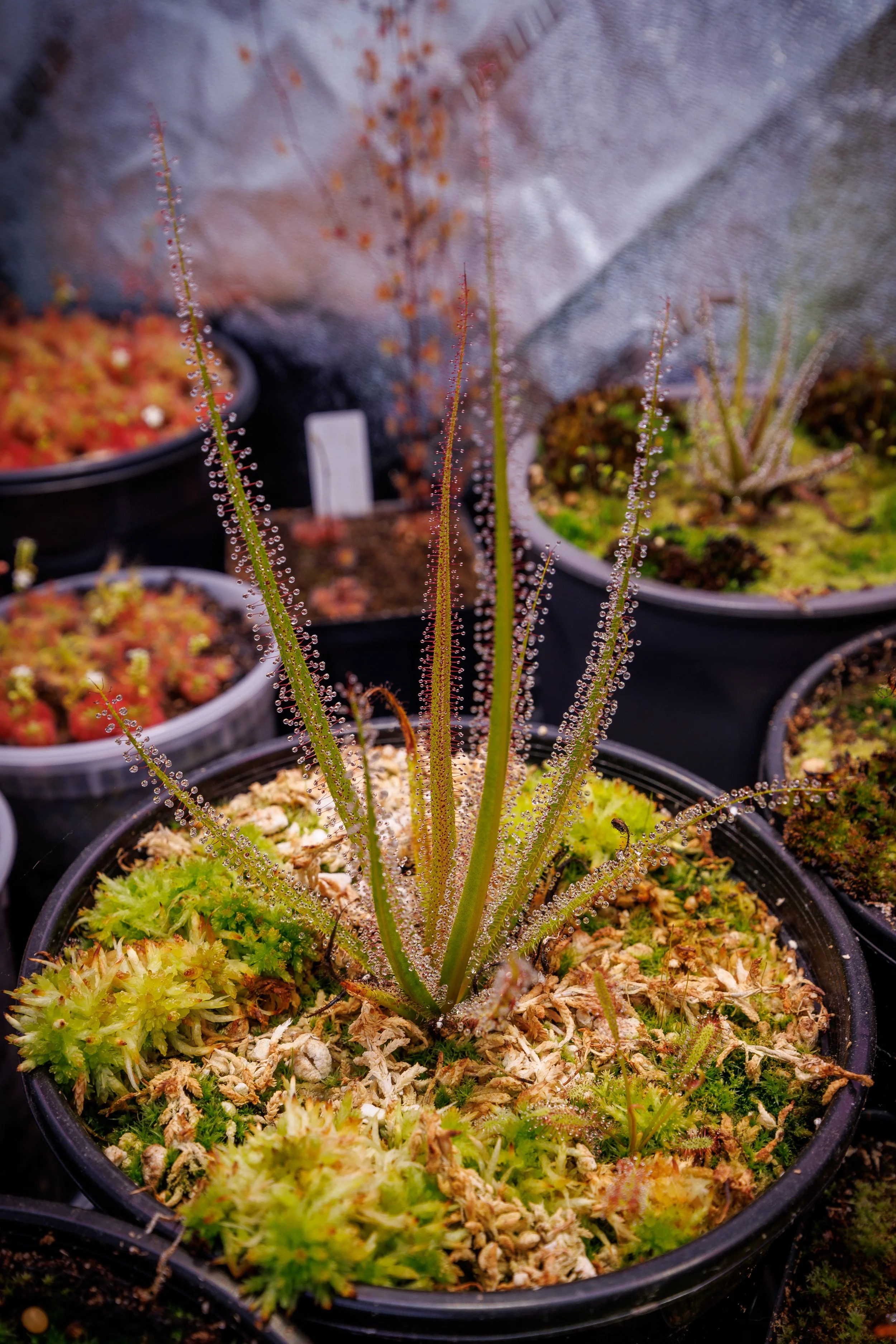King Sundew (Drosera regia) Cultivation




General Info:
Drosera regia is known as the King Sundew for it’s massive size, with the largest leaves of all sundews. The lance-shaped leaves can grow up to 2’ in length with huge dew drops. Smaller leaves can not only curl their tentacles, but will also bend and twist the leaf blade to wrap around large prey. An old plant can split into many growth points to almost form a bush of giant, sticky leaves. It is distantly related to the other Drosera and some say it could be its own genus. Undoubtedly one of the most desirable of all the carnivorous plants and a spectacular plant in any collection.
Native to South Africa, these grow in the small mountains of the Western Cape in well-drained, moist soils. This habitat can get frost or even light snow in the winter, and summers stay quite cool due to the elevation and fog. They can grow to a huge size incredibly fast, but this requires heavy feeding. Unlike other sundews, Drosera regia benefits from root fertilization. To grow this successfully requires cool temperatures, strong light, proper winter dormancy, and regular feeding. While it can grow without winter dormancy as a young plant, most growers find that long-term health requires seasonal cues. This can be as simple as changing the photoperiod in winter which induces a mild dormancy of small leaves and slow growth. In spring, massive new leaves will emerge.
Summers can be challenging due to prolonged heat. Most plants can handle hot days (up to 100F) as long as nights cool down into the 70F’s or below. Ensure that the roots stay as cool as possible, and that the sides of the pot are not baking in the sun as this will cook the roots. They are easy to grow under powerful LED grow lights indoors.
Feeding is different for Drosera regia compared to all other Drosera. I usually feed a combination of insect powder on the leaves, liquid fertilizer spray on the leaves, and fertilizer in the soil/water tray. One of these methods alone should be sufficient if care is taken to feed enough without overfeeding. If they are fed heavy amounts of fertilizer, they should be kept in their own trays or with plants that tolerate higher nutrient levels in the soil (e.g. Sarracenia).
Cultivation:
Climate: Cool Mediterranean climate is best, roughly 40-90F, especially limiting heat in summer. It can survive a light frost by dying back to the roots to re-emerge in spring. Ideally it will stay below 90F but it can tolerate higher temperatures if the roots can stay cool. High humidity is not necessary and can actually promote rot — lower humidity is best.
Light: Part to Full Sun or at least 15W per sq ft LED light. They love light and will grow floppy, elongated, green leaves in overly dim conditions. Full sun can cause the leaves to grow vertically and very compact during the intense sun of summer.
Water: Distilled or Reverse Osmosis water. Sitting in 0.5”-1” of water using tray method, or regular top watering. These prefer not to be overly soggy but do fine in trays with adequate light and feeding.
Soil: Soil can be pure long-fibered sphagnum moss or peat/perlite/sand mixes. It is not picky, but prefers peat based mixes in my experience, and especially sphagnum moss. Use very large and deep pots as the roots can grow several feet long on mature plants.
Feeding: Drosera regia requires regular feeding to survive long-term. The leaves can be fed with fish food or bugs and they will dramatically curl around the food. Drosera regia can also be root fertilized with dilute Dynagro Foliage Pro or MaxSea. A solution of 300-400ppm can be made, using ~1mL per inch of pot diameter. Some growers will use slow-release fertilizer pellets, but this is best left to experienced growers.
Notes:
These require regular feeding to survive and thrive. They should be fed quite heavily every few weeks to sustain healthy growth.
Winter dormancy seems to be important for long term health and should be respected. Indoors, the photoperiod should be adjusted throughout the year to signal seasonal changes.
Older plants will send up new growth from the roots and create clumps of large leaves.